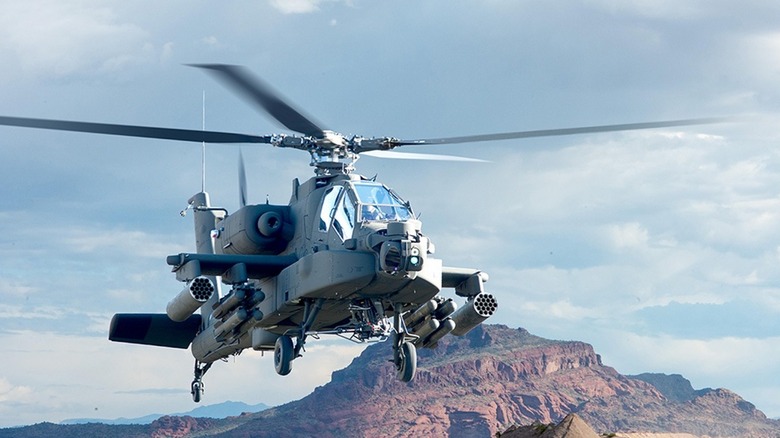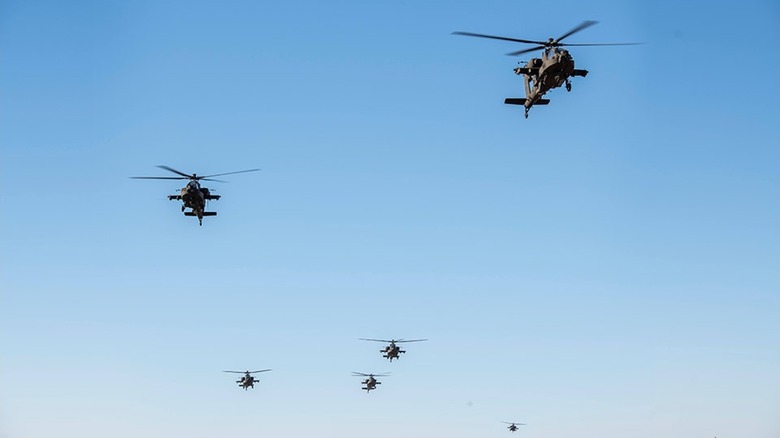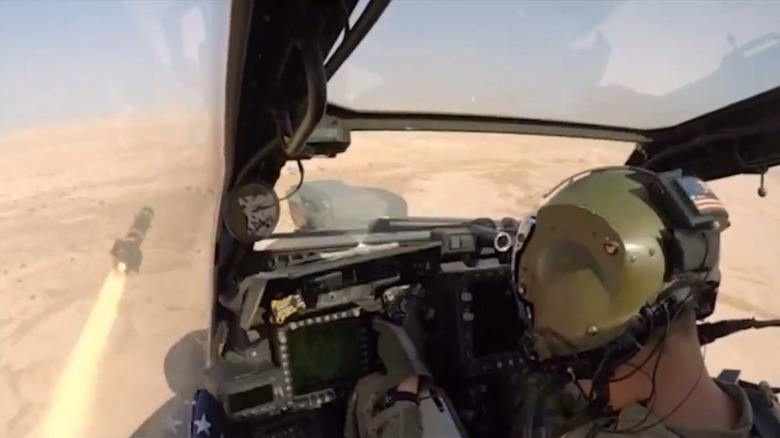How Many Apache Helicopters Does The US Have?
Few military helicopters are as intimidating as the U.S. Army's Apache. The first model, the AH-64A, entered American service in 1984; since then, variations of the Apache have been deployed to conflicts in Panama, Iraq, and Afghanistan, to name a few. According to Boeing, from the A to E model variants, the U.S. Army has racked up over 1.3 million combat hours and more than 5 million flight hours. While the United States is hardly the only country with these highly advanced attack choppers, American forces have the most, by a wide margin. According to the Flight Global 2025 World Air Forces directory, the US Army has a total of 824 AH-64 helicopters, primarily made up of a mix of D and E variants. Of course, this is just the tip of the iceberg in terms of choppers, as the U.S. Army's helicopter fleet is bigger than you think.
The most recent Apache (AH-64E Version 6) is the most enhanced and capable iteration yet, with improvements to sensors, weapon effectiveness, and more sophisticated software. Capable of a maximum speed exceeding 150 knots (172 miles per hour), a flight ceiling of 20,000 feet, and plenty of protective armor, the AH-64E v6 is a nightmare for opposing forces, especially units on the ground. It packs 16 AGM-114 HELLFIRE missiles (which are laser-guided and designed to punch through tank armor and structures), 76 rockets, and a 30 mm chain gun equipped with 1,200 rounds, among other configurations.
What does the Apache E-model offer over the D-model
Aircraft manufacturer Boeing produced the AH-64D iteration from the late 90s up to 2013. While not the most current version of Apache, the D-model is still highly capable and active in militaries across the globe. The AH-64D features several upgrades over previous models, such as greater weapons accuracy at long range, combat proficiency at night and during inclement weather, better detection capabilities without alerting targets, and enhanced technology that improved communication and imagery systems. The Apache even has wire cutters in the front.
The Apache E-model takes improvements a step further with faster and more secure network communication via advanced digital connectivity. This cutting-edge attack helicopter features a Joint Tactical Information Distribution System (JTIDS), which is specially crafted for delivering encrypted data and vocal communications in unfriendly territory. Recently, the Army contracted with BAE Systems to use its Multi-mode Aviation Radio Set (MARS) for rotary aircraft, including the Apache, with Type 1 Crypto Modernization and jam-resistant technology. The AH-64E also received higher output engines (T700-GE-701D) and more robust transmission components.
Lastly, the Apache can now operate unmanned aerial vehicles (UAVs). The Army began pairing the Apache with UAVs back in 2014, allowing for lower human risk in scouting, which was previously handled by Kiowa helicopters. Due to the advanced nature of the systems onboard the E-model, it's ideally suited for working with drones to further enhance battlefield awareness.
The U.S. Army has also been perfecting the Apache's drone hunting skills
The modern battlefield is increasingly seeing aerial drones become active for a variety of missions. Most often thought of as primarily a reconnaissance tool, these unmanned aircraft can also carry weapons, such as the MQ-9 Reaper, which is surprisingly fast (and expensive).
However, it isn't just the U.S. and its allies with the ability to attack using drone technology, as some militant groups in the Middle East have a history of employing "kamikaze drones." These can be crafted using commercial drones with explosives attached, designed for a one-way flight ending in a devastating explosion.
To combat threats of this nature, U.S. AH-64D (Longbows) were seen in Saudi Arabia recently, detecting and obliterating various drones during a training exercise. While the AGM-114 HELLFIRE missile is primarily used by the Apache to eliminate ground targets like tanks, an upgraded version also has a knack for blowing enemy drones out of the sky, using a millimeter-wave radar seeker, along with the chopper's onboard radar system.


